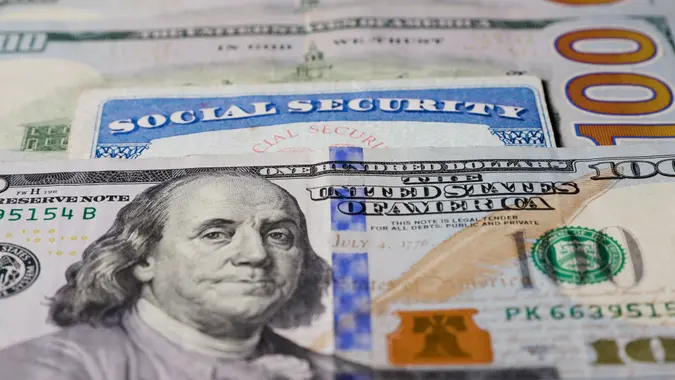How To Stop Creating More Debt

Commitment to Our Readers
GOBankingRates' editorial team is committed to bringing you unbiased reviews and information. We use data-driven methodologies to evaluate financial products and services - our reviews and ratings are not influenced by advertisers. You can read more about our editorial guidelines and our products and services review methodology.

20 Years
Helping You Live Richer

Reviewed
by Experts

Trusted by
Millions of Readers
Every year people stride into the new year with the hopes of eliminating debt. This noble resolution can be difficult to live up to, if only because our capitalist society is designed around accumulating more, more, more — at the cost of racking up debt.
Save More: Unplug These Appliances That Hike Up Your Electricity BillGood To Know: $1M Is No Longer the Standard Nest Egg – Here’s How Much Most Americans Think You Actually Need To Retire
However challenging, tackling debt is possible and it may start rather simply: by not creating more debt. How can one do that? GOBankingRates consulted a number of financial experts to learn their top ways to turn a new leaf and stop accumulating more debt while paying down what they’ve amassed.
Budget With Goals Top of Mind
First, you must stop in your tracks and fully assess — or reassess — your financial situation. This entails sitting down and making a highly detailed budget.
“Establishing goals and a spending plan is the no. 1 way to avoid overspending and stop accumulating debt,” said Sean Fox, president of Freedom Debt Relief. “Start not with the numbers, but by carefully considering and prioritizing goals in your life (with spouse/partner/family as applicable). The goals could range from taking a family vacation to being able to retire at a certain age to making sure you have time to train for a marathon. Then proceed to build your budget around the goals, knowing it will likely mean modifications.”
Get Started: Make a Debt-Free Future Your Reality
From there, Fox recommends writing down (or entering in a spreadsheet) your budget. The budget should include your total monthly net household income, your ongoing monthly expenses by category, savings and spending money.
“Add those up for a total on your cost of living,” Fox said. “See where you stand. If expenses are more than income, or are too high to get you to your goals, there’s no magic solution. The reality is that you must find ways to cut expenses or increase income.”
See: 16 Key Signs That You Will Always Be In Debt
Employ a Simple Budgeting Method — Like the 50/20/30 Technique
There are a few budgeting methods that you can try, but Imani Francies, a finance expert with Clearsurance, recommends the 50/20/30 technique.
“The 50/20/30 technique asks you to put 50% of your income towards your needs, 30% to wants, and 20% to savings,” Francies said. “Following a simple budgeting model increases the likelihood of sticking to it. A more complicated one can be difficult to keep track of and follow, leading to you slipping back into old spending habits.”
More Tips: What Not To Do While Trying To Get Out of Debt
Make Financial Responsibility Part of Your Daily Routine
“Make it part of your daily routine to pay all of your monthly bills promptly the day they arrive so there’s no risk of forgetting or neglecting them later,” said Jonathan Svensson, co-founder of Almvest, a financial education website. “Write down all of the due dates on your calendar so you won’t miss any payment deadlines, and do everything possible to adhere to those deadlines without fail every time. I suggest setting up automated payments so you never miss one.”
Physically Destroy Tempting Credit Cards
One of the oldest tricks in the book is as effective as ever: shredding credit cards.
“Cut up the credit cards you’re currently using to prevent yourself from overspending,” Svensson said. “You can take out cash instead, or only charge purchases that are necessary for your household. Keep the rest of the cards in a safe place, but don’t carry them around with you unless you really need to.“
Helpful: 25 Ways To Save Yourself From Your Debt Disaster
Focus On High-Interest Debt First
“Focus on paying off your high-interest debts first and foremost,” said Carter Seuthe, CEO, Credit Summit. “Be sure to always make your minimum payments across the board, but focus on paying off the high-interest debts so that you can decrease the amount of additional money you have to pay off.”
Find Out: How Much Debt Americans Have at Every Age
Build and Maintain an Emergency Fund
“One of the most impactful ways to stop relying on debt is to build and maintain an emergency fund,” said Andrew Pentis, a certified student loan counselor and student debt expert at Student Loan Hero. “Your emergency or rainy day savings will keep you from having to borrow if you experience an unforeseen expense, such as having to fix your car or cover medical expenses. It’s generally wise to keep at least three to six months’ worth of your expenses in your emergency fund. You can calculate your monthly expenses by establishing a budget, one of the other major ways to keep spending within your means and avoid creating debt.”
If saving up three to six months of expenses seems like a tall mountain to climb, Pentis suggests starting small.
“Aim for a $1,000 emergency fund by dedicating a little bit of each paycheck to your new savings goal,” he said. “Once you’ve hit four digits, you’ll feel more confident about your ability to fully fund your emergency savings. And when you inevitably have to dip into the account, set a new goal to replenish it when you’re able. Lastly, sock away the emergency savings in a high-yield, interest-bearing account to ensure that your funds grow, little by little, when they’re not being used.”
Related: 19 Ways To Tackle Your Budget and Manage Your Debt
Consider a Balance-Transfer Offer
“If you have multiple credit cards or high-rate loans, doing a balance transfer may be a good idea,” said Laura Adams, MBA, a personal finance and credit expert for Finder. “They typically charge 0% interest during a promotional period, such as 12 to 18 months, which cuts your interest expense so you can pay more toward the principal balance of your debt.”
Track Your Debt Payoff Date
“Many individuals don’t hesitate to add more debt because they see the additional debt as just another monthly payment to make,” said R.J. Weiss, a certified financial planner and founder of the personal finance site The Ways to Wealth. “After all, what’s another $50 a month? The problem with this approach is that it compounds, and every $50 added makes it more difficult to pay off your debt.”
This is problematic thinking that could land you in a deeper pile of debt.
“A way to reframe how much debt you actually owe is to figure out how long it will take you to pay off your debt,” Weiss said. “Specifically, track how many months until you’re debt free. The power of this approach is that it allows you to make better decisions today because everything can be framed in terms of, ‘Will this increase or decrease my estimated debt payoff date?’ Now, that same $50 a month might extend your debt payoff by months.”
More From GOBankingRates
 Written by
Written by  Edited by
Edited by 
























